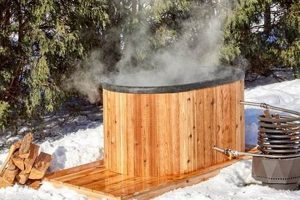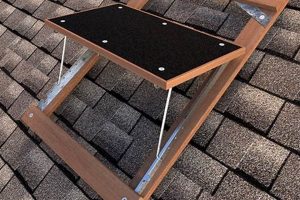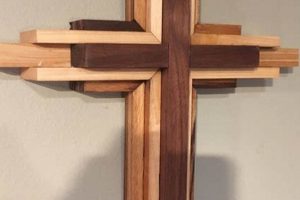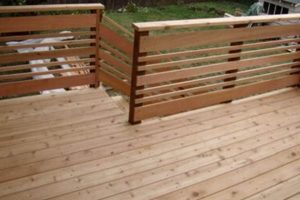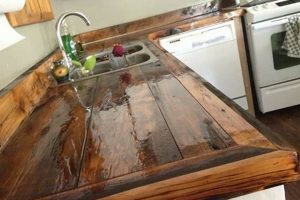A do-it-yourself project involving the creation of a table utilizing wood as the primary material. This undertaking typically entails individuals designing, constructing, and finishing a functional piece of furniture, customized to their specific needs and preferences. For example, one may build a small side table from reclaimed lumber, tailoring the dimensions to fit a specific space.
Constructing furniture offers numerous advantages, including cost savings, customization options, and the satisfaction derived from creating a useful object. Historically, crafting furnishings was a necessary skill, particularly in times and locations where commercially manufactured goods were unavailable or unaffordable. Modern interest reflects a renewed appreciation for craftsmanship and individualized design.
The subsequent sections will delve into the selection of suitable wood types, outline essential tools and techniques, provide step-by-step construction guidance, and offer finishing tips to ensure a durable and aesthetically pleasing result. This guidance supports the successful realization of personalized furniture projects.
Essential Considerations for a Self-Made Wooden Table
The following recommendations aim to optimize the construction process and ensure the longevity and aesthetic appeal of a self-made wooden table.
Tip 1: Material Selection: Prioritize hardwood species such as oak, maple, or walnut for tabletop construction due to their superior durability and resistance to wear. Softwoods like pine are more suitable for less critical components, such as aprons or legs, provided appropriate reinforcement is incorporated.
Tip 2: Precise Measurement and Cutting: Accurate measurements and clean cuts are paramount for achieving a structurally sound and visually appealing table. Utilize precision measuring tools and a high-quality saw with an appropriate blade for the chosen wood species. Deviations from the intended dimensions can compromise the integrity of the finished piece.
Tip 3: Joint Selection and Execution: The chosen joint types should be appropriate for the intended load and aesthetic requirements. Mortise and tenon joints offer exceptional strength, while simpler joinery methods such as butt joints require reinforcement with screws or dowels. Precise execution of these joints is critical for structural stability.
Tip 4: Adequate Sanding and Preparation: Thorough sanding is essential for creating a smooth, even surface for finishing. Start with a coarse grit sandpaper and gradually progress to finer grits. Remove all sanding dust before applying any finishing products.
Tip 5: Appropriate Finishing Application: Select a finish that provides adequate protection against moisture, scratches, and UV damage, based on the intended use of the table. Apply multiple thin coats, allowing each coat to dry completely before applying the next. Consider using a sealant or primer to enhance the finish’s adhesion and durability.
Tip 6: Hardware Considerations: Use high-quality screws, bolts, and other hardware components to ensure a secure and long-lasting assembly. Choose hardware that is compatible with the chosen wood species and finish.
Tip 7: Structural Reinforcement: Evaluate the design for potential weak points and incorporate appropriate reinforcement, such as aprons, stretchers, or corner braces. These elements enhance the table’s stability and prevent sagging or warping over time.
Implementing these guidelines contributes significantly to the creation of a robust and visually pleasing piece of furniture. Meticulous attention to detail throughout the design and construction phases is critical for achieving a successful outcome.
The subsequent sections will explore advanced techniques and design considerations for constructing more complex and specialized furniture designs.
1. Wood Type
The selection of wood is a foundational decision in the construction of a self-made wooden table, directly influencing its structural integrity, aesthetic qualities, and overall longevity. The properties inherent to various wood types dictate their suitability for specific table components and design considerations.
- Hardwood vs. Softwood: Strength and Durability
Hardwoods, derived from deciduous trees, exhibit greater density and resistance to wear compared to softwoods from coniferous trees. For table tops and load-bearing elements, hardwoods such as oak, maple, and walnut are preferred due to their ability to withstand daily use and resist denting. Softwoods like pine or fir may be suitable for less critical components, such as aprons or legs, but require careful design and joinery to ensure adequate support.
- Grain Pattern and Aesthetic Appeal
Different wood species possess unique grain patterns that contribute significantly to the table’s visual character. Straight-grained woods like maple offer a clean, contemporary aesthetic, while woods with prominent grain patterns like oak or ash lend a more rustic or traditional feel. Knotty woods, such as pine, can add character but may also present challenges in terms of structural integrity and finishing.
- Workability and Ease of Construction
The workability of a wood species influences the ease with which it can be cut, shaped, and joined. Softer woods are generally easier to work with hand tools, while hardwoods may require power tools and specialized techniques. The choice of wood should align with the builder’s skill level and available tools to ensure a successful construction process.
- Moisture Content and Stability
Wood is a hygroscopic material, meaning it absorbs and releases moisture from the surrounding environment. Fluctuations in moisture content can lead to warping, cracking, or shrinking of the wood. Properly drying and acclimating the wood to the intended environment is crucial for ensuring the table’s stability over time. Kiln-dried lumber is generally preferred for furniture construction due to its lower and more stable moisture content.
The interplay between wood type and the intended table design is paramount. A robust hardwood table top paired with softwood legs may present a cost-effective solution, while a table crafted entirely from a single, high-quality hardwood species offers unparalleled durability and aesthetic consistency. Ultimately, the optimal wood selection reflects a careful consideration of functional requirements, desired aesthetic, and the builder’s skill set.
2. Table Design
Table design constitutes a critical element in the do-it-yourself wooden table creation process. Design decisions directly impact the table’s functionality, aesthetic appeal, structural integrity, and overall suitability for its intended purpose. A well-conceived design minimizes material waste, simplifies construction, and ensures a durable and visually pleasing end product.
- Form and Function Relationship
The chosen form must align with the table’s intended function. A dining table requires a large, stable surface, while a side table may prioritize compactness. Considerations include surface area, height, leg placement, and the incorporation of features such as drawers or shelves. For example, a trestle table design, while visually appealing, may not offer the same stability as a four-legged design for heavy use.
- Aesthetic Considerations
The design should complement the surrounding environment and reflect the desired aesthetic. This involves selecting appropriate shapes, lines, and proportions. A minimalist design may feature clean lines and a simple rectangular top, while a rustic design may incorporate reclaimed wood and natural edges. The integration of design elements, such as aprons or decorative joinery, further contributes to the table’s overall aesthetic.
- Structural Integrity and Stability
The design must ensure the table’s structural integrity and stability under anticipated loads. This involves selecting appropriate materials, joinery methods, and reinforcement techniques. For instance, a large table may require thicker legs and a robust apron system to prevent sagging. The design should also consider potential stresses and strains, particularly at joints, and incorporate features to mitigate these forces.
- Ergonomics and User Experience
The design should promote comfortable and efficient use. This includes considerations such as table height, leg clearance, and the placement of any integrated features. A dining table should be designed to accommodate comfortable seating, while a workbench should provide ample work space at a suitable height. Attention to ergonomic details enhances the user’s overall experience and promotes long-term satisfaction.
The integration of these design facets is paramount for creating a successful self-made wooden table. A holistic approach that considers form, function, aesthetics, structural integrity, and ergonomics results in a piece of furniture that is both visually appealing and functionally sound, fulfilling its intended purpose for years to come. Subsequent stages of the construction process depend directly on the solidity of the design phase.
3. Joint Strength
Joint strength is a fundamental determinant of a self-made wooden table’s structural integrity and longevity. The efficacy of the joinery directly influences the table’s ability to withstand applied loads, resist deformation, and maintain its intended form over time. Inadequate joint strength precipitates structural failure, rendering the table unstable and potentially unusable. For instance, a dining table constructed with poorly executed butt joints secured only with screws is likely to exhibit wobble or collapse under the weight of dishes and serving ware. Conversely, a table utilizing mortise and tenon joints, properly sized and fitted, demonstrates superior resistance to stress and strain.
The selection of appropriate joint types is contingent upon the table’s design, intended use, and the characteristics of the wood employed. High-stress applications, such as table legs supporting a heavy top, necessitate robust joinery methods like mortise and tenon, dovetail, or bridle joints. Simpler joints, such as butt joints or lap joints, may suffice for less critical components like aprons or drawer supports, provided they are reinforced with screws, dowels, or glue. The execution of each joint demands precision and attention to detail. Ill-fitting joints compromise structural integrity regardless of the joinery method. For example, a loose mortise and tenon joint, even when glued, provides significantly less strength than a tightly fitted joint. Furthermore, the type of adhesive used significantly impacts joint strength. High-quality wood glues designed for furniture construction, when properly applied, create bonds stronger than the wood itself.
In summary, joint strength is a non-negotiable factor in the successful construction of a self-made wooden table. It is the linchpin that connects individual components into a cohesive and functional whole. Ignoring this crucial aspect can lead to premature failure, negating the time, effort, and materials invested in the project. A thorough understanding of joinery principles and meticulous execution are essential for creating a table that is both aesthetically pleasing and structurally sound, capable of withstanding the rigors of daily use for years to come.
4. Surface Finish
The surface finish applied to a self-made wooden table represents the culminating step in the construction process, significantly influencing its aesthetic appeal, durability, and overall utility. A well-executed finish enhances the wood’s natural beauty while providing a protective barrier against environmental factors and daily wear.
- Protection Against Environmental Factors
Surface finishes safeguard the underlying wood from moisture, ultraviolet (UV) radiation, and temperature fluctuations. Moisture penetration can lead to warping, swelling, and fungal growth, while UV exposure can cause fading and discoloration. Finishes such as varnish, polyurethane, and lacquer form a protective film that mitigates these effects, extending the table’s lifespan. For example, an exterior-grade finish applied to a table intended for outdoor use shields it from the elements, preventing premature degradation.
- Enhancement of Aesthetic Qualities
Different finishes impart varying levels of sheen, color, and texture, thereby influencing the table’s visual character. Oil finishes, such as linseed or tung oil, penetrate the wood fibers, enhancing the grain pattern and providing a natural, low-luster appearance. Stains can alter the wood’s color, allowing for customization and matching to existing dcor. The selection of finish directly impacts the overall aesthetic, ranging from rustic and matte to contemporary and glossy.
- Durability and Resistance to Wear
The surface finish contributes significantly to the table’s resistance to scratches, stains, and abrasion. Harder finishes, such as polyurethane and epoxy, provide a durable, impact-resistant surface ideal for high-traffic areas. Softer finishes, such as wax, offer less protection but are easier to repair and maintain. The intended use of the table dictates the required level of durability; a dining table necessitates a more robust finish than a purely decorative piece.
- Application Techniques and Considerations
The successful application of a surface finish requires careful preparation and adherence to specific techniques. Proper sanding is essential for creating a smooth, even surface that promotes finish adhesion. Multiple thin coats are generally preferred over a single thick coat to prevent runs, drips, and uneven drying. Factors such as ambient temperature, humidity, and the type of applicator (brush, spray gun, or cloth) also influence the final result. A meticulously applied finish not only enhances the table’s appearance but also ensures optimal protection and longevity.
In summary, the surface finish is not merely a cosmetic treatment but an integral component of a self-made wooden table. Its proper selection and application significantly impact the table’s durability, aesthetic appeal, and overall value. By carefully considering the intended use, desired aesthetic, and the properties of available finishes, one can create a table that is both beautiful and functional for years to come.
5. Leg Stability
Leg stability is a critical factor in the design and construction of a self-made wooden table. The primary function of a table’s legs is to provide stable support for the tabletop and any load it bears. Insufficient leg stability results in a wobbly or unstable table, rendering it functionally impaired and potentially hazardous. For instance, a dining table with poorly attached or inadequately sized legs may collapse under the weight of a holiday meal, causing injury and damage. Therefore, ensuring leg stability is paramount to creating a durable and safe piece of furniture. The design of the legs themselves, their placement, and the method of attachment to the tabletop or supporting structure all contribute to the overall stability of the table.
Various methods exist to enhance leg stability in a self-made wooden table. These include using thicker leg stock, splaying the legs outward to increase the footprint of the table, incorporating aprons or stretchers to create a more rigid frame, and employing robust joinery techniques such as mortise and tenon or dovetail joints. The specific method chosen should be appropriate for the size and intended use of the table. For example, a small side table may only require a simple butt joint reinforced with screws, while a large dining table necessitates more substantial joinery and additional support structures. Careful consideration of these factors during the design and construction phases is essential for achieving optimal leg stability. Furthermore, the type of flooring upon which the table will be placed can influence stability. Uneven floors may require adjustable feet to ensure the table sits level.
In conclusion, leg stability is an indispensable component of a functional and safe self-made wooden table. Neglecting this aspect can compromise the table’s utility and present safety hazards. By carefully considering leg design, placement, and attachment methods, and by implementing appropriate reinforcement techniques, a stable and durable table can be achieved. This understanding allows for practical application in various table designs, ensuring the final product meets its intended purpose effectively and safely. Prioritizing leg stability ultimately contributes to the longevity and user satisfaction of the crafted wooden table.
6. Cost Efficiency
The appeal of constructing a wooden table often stems from the potential for achieving cost savings compared to purchasing a similar piece of furniture. The extent of these savings depends on several factors, including the type of wood selected, the complexity of the design, the availability of tools, and the level of skill possessed by the builder. Procuring reclaimed lumber, for instance, can significantly reduce material costs, albeit potentially requiring additional effort in terms of preparation and processing. Simplifying the design, utilizing readily available materials, and minimizing waste during construction all contribute to enhanced cost efficiency. The initial investment in necessary tools, such as saws, drills, and measuring devices, should be factored into the overall cost assessment. However, these tools represent a one-time expenditure and can be utilized for subsequent projects, further enhancing the long-term cost-effectiveness of do-it-yourself woodworking.
A practical example illustrating the potential for cost savings involves constructing a basic dining table. Purchasing commercially available hardwood tables of comparable size and quality can range from several hundred to several thousand dollars. By sourcing lumber directly from a sawmill or utilizing reclaimed materials, and constructing the table using relatively simple joinery techniques, the total material cost can potentially be reduced by a factor of two or more. Furthermore, customization options are expanded, allowing the builder to tailor the dimensions, style, and finish to specific requirements, a feature often unavailable or prohibitively expensive with mass-produced furniture. This control over design and materials also allows for optimizing material use and reducing waste, directly contributing to cost efficiency. It is essential to conduct a thorough cost analysis, considering all potential expenses, before commencing the project, to accurately assess the feasibility and potential savings.
Achieving cost efficiency in a do-it-yourself wooden table project requires a balanced approach that considers material selection, design complexity, and labor input. While the potential for significant savings exists, it is crucial to avoid compromising on quality or structural integrity in pursuit of cost reduction. A poorly constructed table, utilizing inferior materials or inadequate joinery, may ultimately prove more expensive in the long run due to the need for repairs or replacement. The core value of the endeavor often extends beyond mere financial savings, encompassing the satisfaction of creating a functional and aesthetically pleasing object, and the opportunity to develop valuable woodworking skills. The interplay between cost efficiency, quality, and personal fulfillment is a key consideration in undertaking such a project.
Frequently Asked Questions
The following section addresses common inquiries regarding the design, construction, and maintenance of self-made wooden tables.
Question 1: What wood species is most suitable for a durable tabletop?
Hardwood species such as oak, maple, and walnut exhibit superior resistance to wear and tear compared to softwoods like pine or fir. These hardwoods are recommended for tabletops intended for heavy use.
Question 2: What is the optimal method for joining table legs to the tabletop?
Mortise and tenon joints provide a strong and stable connection between table legs and the tabletop. Alternatively, aprons can be used to reinforce the joint and distribute weight evenly.
Question 3: How can warping of the tabletop be prevented?
Employing kiln-dried lumber with a low moisture content minimizes the risk of warping. Sealing all surfaces of the wood with a suitable finish helps regulate moisture absorption and prevent dimensional changes.
Question 4: What type of finish is best for protecting the table from spills and stains?
Polyurethane and lacquer finishes offer excellent protection against spills and stains. These finishes form a durable, water-resistant barrier that prevents liquids from penetrating the wood.
Question 5: How can a wobbly table be stabilized?
Inspect the leg joints for looseness and tighten or re-glue them as needed. Installing levelers on the bottom of the legs allows for fine-tuning the table’s balance on uneven surfaces.
Question 6: What are the essential tools required for constructing a wooden table?
Essential tools include a saw (hand saw, circular saw, or table saw), drill, measuring tape, level, sandpaper, and clamps. Additional tools such as a router or planer may be required for more complex designs.
These FAQs provide a foundational understanding of the key considerations involved in table construction. Further research and consultation with experienced woodworkers can enhance the success of individual projects.
The subsequent section will provide resources and additional materials for further learning about woodworking projects.
Conclusion
This exploration of the diy wooden table has highlighted essential considerations for successful construction. From wood selection and joint strength to surface finishing and leg stability, adherence to established principles ensures both aesthetic appeal and structural integrity. Cost efficiency, while a potential benefit, must be balanced with quality to prevent premature failure.
The construction of a robust and visually pleasing diy wooden table represents a significant undertaking. Whether for functional utility or personal satisfaction, the endeavor necessitates careful planning and meticulous execution. Future trends in sustainable materials and innovative joinery techniques promise further advancements in this craft, offering expanded possibilities for personalized furniture creation.



